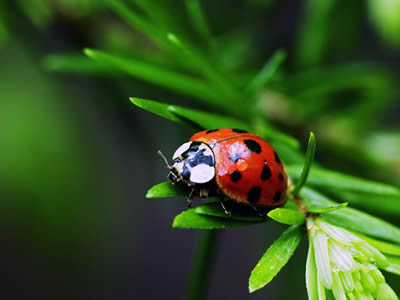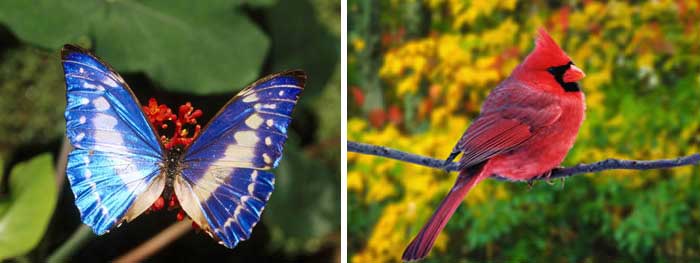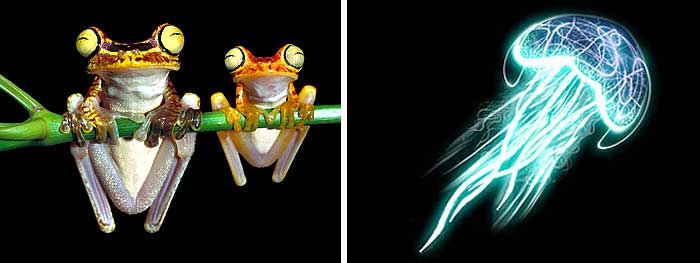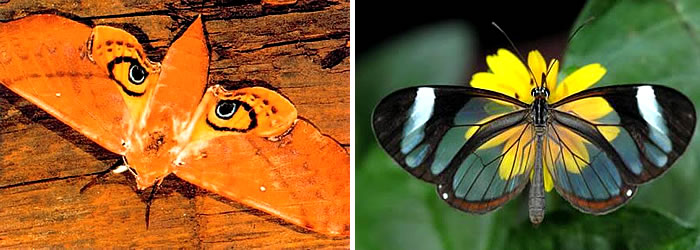A Topic Evolution cannot Explain: Harmony and Symmetry
 |
On the earth we inhabit and in the wider universe in which the earth is located great harmony prevails. Even by looking out of the window, we see many examples of this harmony. In the clouds, in the sky, trees, flowers, animals and in similar examples, perfect order and symmetry is apparent.
When we look at nature, we see that every plant and every animal have their own particular colours and patterns exclusive to their kind. Furthermore, each of these colours and patterns have different meanings for living things: an invitation to mate, expression of aggression, a warning against danger and many notions like these acquire a meaning among animals from the perception of colours and patterns.
The theory of evolution, which claims that everything has come into being by random coincidence, has reached a total impasse because of the artistry, diversity of colours and harmony exhibited in nature. Charles Darwin, the founder of the theory in the form in which we have it today, also had to confess the situation he faced because of the design evident in living beings. Darwin stated that he could not understand why the colours of living creatures have particular meanings:
My difficulty is, why are caterpillars sometimes so beautifully and artistically coloured? Seeing that many are coloured to escape danger, I can hardly attribute their bright colour in other cases to mere physical conditions. If any one objected to male butterflies having been made beautiful by sexual selection, and asked why should they not have been made beautiful as well as their caterpillars, what would you answer? I could not answer but should maintain my ground.55
Again Charles Darwin expresses the conflict he came into with his own theory as follows:
I value the cases of bright-coloured, incubating male fishes, and brilliant female butterflies, solely as showing that one sex may be made brilliant without any necessary transference of beauty to the other sex; for in these cases I cannot suppose that beauty in the other sex was checked by selection.56
 |
Certainly, it is impossible for colours, order and symmetry in nature to have come into being by natural selection. At this point, it would be useful to have a closer look at the concept of "natural selection" put forward by the Darwinian theory of evolution. As is well known, natural selection is one of the imaginary mechanisms of the theory of evolution. It holds that those best fitted to their environment will survive, while those who are weak and unfit for environmental conditions will be eliminated. According to the claims of evolutionists, a beneficial change occurs in a member of a species through a random mutation in its genes. That creature is selected from among all others of that species by the mechanism of survival of the fittest, and thus what was a random mutation is transferred in larger amounts to the next generation.It is definitely not possible for colours, patterns and the symmetry in the patterns of living beings to have been created through such a mechanism. This is a very obvious fact. Although he is the founder of the theory, Darwin himself had to confess that the imaginary mechanism of natural selection could not be the cause of such an order. Also, British archaeologist J. Hawkes questions the meaninglessness of natural selection in his article "Nine Tantalizing Mysteries of Nature", published in New York Times magazine:
I find it difficult to believe that the extravagant glories of birds, fish, flowers and other living forms were produced solely by natural selection; I find it incredible that human consciousness was such a product. How can man's brain, the instrument which created all the riches of civilization, which served Socrates, Shakespeare, Rembrandt, and Einstein, have been brought into being by a struggle for survival among hunters of wild game in the Pleistocene wilderness?57
As understood from those confessions of evolutionists, they know that their theory is in crisis. It is unreasonable to defend the idea that a cell, which supposedly came into existence coincidentally as a result of lightning and rains on the earth, turned into multicoloured living things over time. Suppose a scientist to take a single cell of a bacterium for instance, provide the most suitable laboratory conditions, use all the equipment required, spend effort on having this cell evolve over millions of years (though this is not possible, let us suppose it is); what would he acquire in the end? Would he ever transform a bacterium into a peacock with its dazzling colours, or into a leopard with perfect patterns on its skin, or into a rose with its red velvet-like leaves? Of course, intelligent people can neither imagine such a thing nor make such a claim. Yet, this is exactly the claim of the theory of evolution.
And mankind and beasts and livestock are likewise of varying colours. Only those of His slaves with knowledge have fear of Allah. Allah is Almighty, Ever-Forgiving.
(Surah Fatir: 28)
The "Colour" Impasse of Evolution
Let us verify with an example that it is impossible for the colours of living beings and systems of transformation of colour to come about by natural selection. Let us take chameleons for an example. Chameleons are animals capable of adapting to the colours present in the environment and changing their colours according to the surroundings. While resting on a green leaf, they assume a green colour, while moving onto a brown branch, their skin changes to brown in a very short time. Let us think together over how this process of colour change takes place.
A living creature changes its colour as a consequence of highly complex processes taking place in its body. It is impossible for a man to change either his own colour or another living being's colour, because the human body is not equipped with the proper systems for such an operation. Nor is it possible for a human to develop such a system on his own because it is not like a piece of equipment to be developed and installed. In short, for a living creature to be able to change its colour, it is imperative for this creature to come into being with such a colour change mechanism.
Let us think about the first chameleon on the earth. What would happen if this creature did not have the ability to change colour? First, the chameleon would be easy prey since it could not hide. Besides, since it would be easily recognised, hunting would be very difficult for it. This would finally cause a chameleon devoid of any other defence mechanism to die or starve and, after a while, to become extinct. Yet, the existence of chameleons in the world today evidently proves that such an event has never taken place. So, chameleons possessed this perfect system from the first moment they appeared on earth.
 |
 |
 |
 |
| It is Allah Who determines the colours of all living beings in nature. |
 |
| Chameleons are one of the creatures that change colour most rapidly according to their surroundings. It is certainly not possible for a chameleon to make a system so complex as changing the colour of its body cells in such a short time on its own. This system present in chameleons is a product of matchless design. And this design belongs to Allah, the most Wise. |
Evolutionists claim that chameleons have developed this system over time. This would make some questions occur to our minds: why have chameleons chosen to develop such a complex system such as changing colour instead of an easier defence mechanism? Why has it chosen changing colour while there are so many kinds of defence mechanisms? How has such a mechanism, providing for all the chemical processes necessary for colour change, been formed in the chameleon? Is it possible for a reptile to think of such a mechanism and then develop the necessary systems in its body? More, is it possible for a reptile to encode the information necessary for colour change in the DNA present in its cells?
Unquestionably, this is impossible. The conclusion to be drawn from the answers given to such questions as above will be one and the same: it is impossible for a living creature to develop such a complex system that allows it to change its own colour.
 |
 |
| Allah bestows the colours and patterns on these insects. |
 |
 |
Not only systems of colour change, but also the diversities of colour and pattern in living beings deserve focus. It is impossible for the bright colours in parrots, the diverse colours in fish, the symmetry in the wings of butterflies, the fascinating patterns in flowers and the colours of other living things to have been formed on their own. Such perfect patterns, colours and figures, which serve very important purposes in the lives of living things, are concrete evidence of creation. It is obvious that there is a superior design in the formation of the colours around us.
Let us make it clear with an example: let us suppose that we are designing a product consisting of squares. Even to draw one of them, we need to make a small calculation and make sure that all four sides are linear and equal and the square has 90-degree angles at the corners. We can draw the square only after making some calculations and adjustments. As seen, even drawing a single square requires some knowledge and skill.
Let us apply the same reasoning to living creatures around us and ponder on them. There is perfect harmony, order and plan in living beings. A person who appreciates the necessity of knowledge and skill in drawing a simple square, will understand right away that origination of the order, harmony, colours and design in the universe is also a product of infinite knowledge and skill. Therefore there is no reasonable or scientific ground for claiming that a system such as the universe has come into existence by chance. Allah, the Most Powerful, has created the entire universe. Allah is the One Who fashions everything He creates most beautifully.
The Symmetry in Nature Cannot Originate by Chance
One of the most striking points producing harmony in the universe is symmetry. Living things have symmetric structures. Anything we see in nature, a seed for instance, a fruit or a leaf we examine will show us symmetry in their structure. Let us take a leafy plant. Leaves wind around the body of the plant like a spiral. This is a certain type of symmetry. Similarly, an observable order rules in the arrangement of the grains of a seed and in the design of the veins of the leaf.
Butterfly wings are another example of the symmetry in nature. On both wings of a butterfly are the same shades of colour and patterns. A pattern on one wing is also present on the other in exactly the same place.
 |
| There is perfect symmetry in nature, which could by no means have originated by chance. |
 |
| The symmetry and order evident in the butterflies in the photograph is surely the masterpiece of a Creator. This Creator is Allah, the Almighty. |
We can see many other examples of symmetry around us, a few of which we summarised above. The important thing however is that there is a common conclusion to be drawn from all the given examples. There is a matchless order, or to be more exact, a magnificent artistry displayed in living things. One of the greatest evidences of the fact that the universe could by no means have come into being by coincidence is this subtle order and artistry. In his book titled "The Theory of Evolution and Bigotry", Prof. Cemal Yıldırım states this fact although he is an evolutionist himself:
"It is far from being convincing to attribute this order in living things, which seems to have a particular purpose, to chance or coincidence".58
Allah created everything in the universe within a larger order. Allah has control over all things.
Your God is One God. There is no god but Him, the All-Merciful, the Most Merciful. In the creation of the heavens and earth, and the alternation of the night and day, and the ships which sail the seas to people's benefit, and the water which Allah sends down from the sky – by which He brings the earth to life when it was dead and scatters about in it creatures of every kind – and the varying direction of the winds, and the clouds subservient between heaven and earth,
there are Signs for people who use their intellect.
(Surat al-Baqara: 163-164)
Footnotes
54. Francis Darwin, Life and Letters,Vol.II, p. 275
55. Francis Darwin, Life and Letters,Vol.II, p. 305
56. J. Hawkes, Nine Tentalizing Mysteries of Nature, New York Times Magazine, 1957, p.33
57. Cemal Yıldırım, Evrim Kuramı ve Bağnazlık, Bilgi Yayınevi, Ocak 1989, p.108
